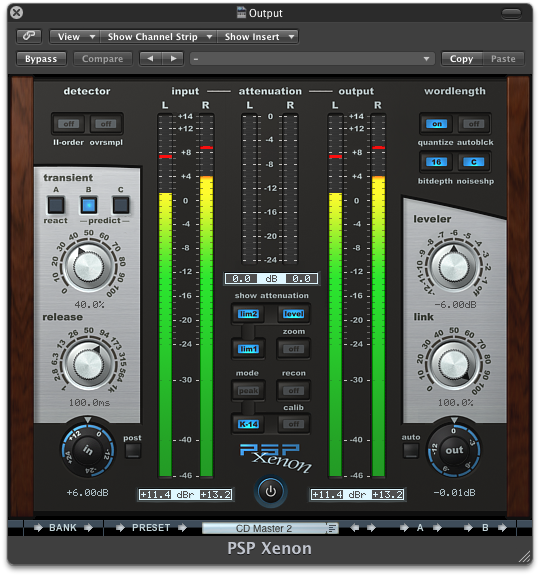

The G console EQ, which loads as the standard-setting, is characterized by its warm EQ section. The SSL Native Channel Strip enables you to choose whether you want the EQ section of either the E or the G console. You can also very intuitively change the layout simply by clicking the arrows that correspond to the routing direction you want to go for. Instead of using some buttons like on many SSL channel emulations, the Native Channel Strip uses boxes and arrows that show you how the different sections are routed. The flexibility of the routing of the different sections also makes this plugin a breeze to use. The larger size allows the knobs to be further away from each other, making it less cluttered than most channel strip plugins. One thing I really like about this plugin is its user-friendly interface. These consoles were used in the mixing of countless records, and are well known for their ability to be used aggressively, without losing musicality. Finally, bypassing the compressor for comparison.The SSL Native Channel Strip attempts to recreate the sonic character of the legendary SSL 4000 E, and G consoles. Acoustic guitar: introducing quite heavy compression with medium attack and auto release, then blending back the dry signal using the mix control.

Snare drum: starting with medium attack, fast release, adding compression then winding up the sidechain filter ending around 800Hz. Kick drum: starting with medium attack, fast release compression gradually winding up the sidechain filter ending at around 300Hz.ģ.
#Cytomic the glue vs waves ssl full#
Finally, switching back to wet mix and between zero range (loud) and full range (compressed).Ģ. Then gradually easing back the range as well. Drum kit: starting with a basic 2:1 ratio, medium attack and release adding more compression by reducing the threshold until the sound is very squashed. Factor in the extra options and you have a very tidy and useful compressor with more real-world uses than the design it's based on. The Glue is a world-class plug-in and, at $99, we reckon it offers amazing value. Next up, both the Mix and Range controls add a host of options for dialling in the compression flavour, and in practice we found this made The Glue an incredibly flexible compressor suitable not just for use on the master bus, but for individual instruments too.įinally, the PeakClip option with its associated red LED is useful if used carefully, though it shouldn't be confused with analogue-style soft saturation, as it will produce harsh distortion if pushed too far. This works well at reducing pumping on mixes, but also helps with fine-tuning compression for low-end heavy sounds, such as basses and kick drums. So, what of the 'new' features? First up, the sidechain filter affects both internal and external sidechain signals and enables you to roll off low frequencies right up to 2kHz.

On the bench, we set up a couple of our favourite SSL settings (subtle pumping mix compression with a 2:1 ratio and a more aggressive setting for drum kit processing), and both had that familiar sound, comparing very well to Universal Audio's 4K Buss Compressor. Threshold, makeup gain and the meter have also been given new names. However, there are some differences, including a super-fast 0.01ms attack option and extra release times (0.4 and 0.8s), while the original 0.3s release time is labelled here as 0.2s. If you're familiar with the SSL original, you'll recognise features such as 'auto' release, three possible compression ratios (2:1, 4:1 and 10:1) and the exact same attack times.


 0 kommentar(er)
0 kommentar(er)
